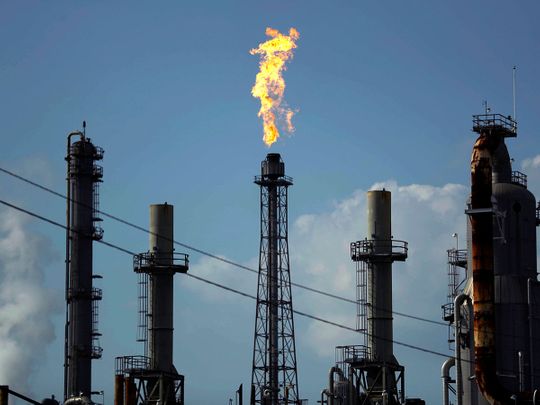
Abu Dhabi: After a brief sense of optimism for oil prices in the wake of production cuts by Opec+, oil markets are back to the reality of grappling with heavy losses in demand, analysts say.
Oil markets on Friday closed on a weekly loss, with Brent trading on $28.08 and West Texas Intermediate (WTI) on $18.27 as the American benchmark dipped below $20, reflecting the pressure oil prices are facing stemming from restrictions on air and land travel in response to COVID-19.
“Oil prices extended their losses last week as the Opec+ production cut agreement has yet to have an impact on the market. Brent futures were down nearly 11%... while WTI lost almost 20%,” said Edward Bell, commodity analyst at Emirates NBD.
“The energy ministers of Saudi Arabia and Russia delivered a joint statement in which they said they were prepared to take “further measures” if needed to support oil markets. If the Opec+ deal carries on last previous iterations we would expect to see voluntary Saudi over-compliance, i.e., cutting more than its share of the deal provided that other producers make an effort to cut output as well,” he added.
“However, demand projections released from the IEA (International Energy Agency) and Opec earlier in the week show just how severe demand has been affected and what kind of cuts would be required to truly bring markets into balance.
“Market structures continue to reflect—and weaken—as a result of this surge of supply overwhelming what little oil demand is out there.”
And further highlighting the challenge oil markets are currently facing, Opec in its latest monthly outlook report forecasted oil demand to drop by more than 6 million barrels per day (bpd) this year with April set to see the heaviest drop.
“For 2020, the world oil demand growth forecast is revised lower by 6.9 million bpd, to a historical drop of around 6.8 million bpd. The contraction in the 2Q (second quarter of 2020) of this year is expected to be around 12 million bpd, with April witnessing the worst contraction at about 20 million bpd,” their report stated.
“The severity of the collapse is likely to result in sharper contraction in oil demand, particularly during 2Q20, extending into 3Q20 and 4Q20. In fact, the contraction is forecast to reach 12 million bpd in 2Q20, about 6 million bpd in 3Q20 and about 3.5 million bpd in 4Q20. Challenges for product markets are expected to continue, as plunging demand could prompt more refiners to reduce, or even halt, operations due to unfavourable economics.”
Opec’s report was more upbeat than the International Energy Agency’s (IEA) forecast, with the IEA estimating oil demand to fall by 9.3 million bpd in 2020 and as high as 23.1 million bpd during the second quarter of 2020.








